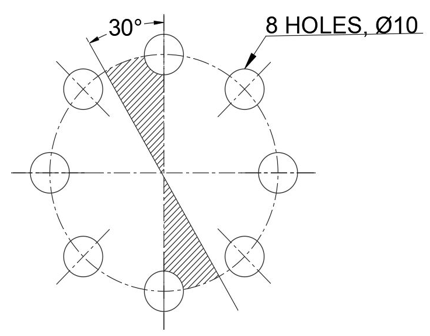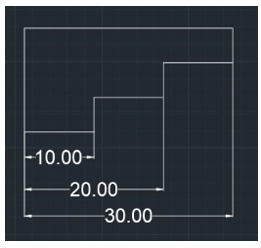This set of Engineering Drawing Multiple Choice Questions & Answers (MCQs) focuses on “Lines, Lettering and Dimensioning – 2”.
1. What does the continuous thin line with zig-zags represent?
a) Cutting Planes
b) Centroidal lines
c) Long-break line
d) Hidden outlines
View Answer
Explanation: When we need to represent the longer lines in the drawing, we reduce the length by long-break lines for the ease of drawing. They are the continuous thin line with zig-zags.
2. In the aligned system of dimensioning for large-size bore or pitch circle, which of the following is true?
a) The dimension should be placed within 30° zone of the vertical central line
b) The dimension should be placed within 45° zone of the vertical central line
c) The dimension should not be placed within 30° zone of the vertical central line
d) The dimension should not be placed within 45° zone of the vertical central line
View Answer
Explanation: Aligned system of dimensioning for pitch circles or bores should be outside the 30° zone of the vertical central line. The example type is shown below, the hatch portion is not suitable for dimensioning.

3. In the unidirectional method of dimensioning, dimensions are placed in such a way that they can be read _______________ of the drawing sheet.
a) Right-hand side
b) Left-hand side
c) Bottom edge
d) Top edge
View Answer
Explanation: Uni-directional system for dimensioning are placed in such a way it is read from the bottom side of the drawings. They are used in large drawings as aircraft, automobiles which are large complex drawing, where it is inconvenient to read the dimensions from the right-hand side.
4. The length of the arrowhead should be ___________ its width.
a) Two times
b) Equal to
c) Three times
d) 0.5 times
View Answer
Explanation: Arrowhead is used at the end of dimensioning lines, touching the extension lines. It is head length should be three times its width. The ratio between arrowheads to width is 3:1.
5. Dimension lines can cross any line of the drawing for better representation.
a) True
b) False
View Answer
Explanation: Dimension lines should not cross any line of the drawing, and even crossing dimension lines should also be avoided. It is better to show the dimensions where it is clear to view and understand.
6. What is the d/h ratio of the lettering type ‘A’?
a) 1/10
b) 1/14
c) 1/12
d) 1/8
View Answer
Explanation: According to the height lettering is classified as lettering ‘A’ and lettering ‘B’. The height of the lettering is proportionate to the thickness of the lettering. In lettering ‘A’, the height of the letter is 14 times the thickness of the letter.
7. Match the following.
| Line type | Application |
|---|---|
| A) Chain thin, with thick ends | i) Cutting Planes |
| B) Chain thin, double-dashed | ii) Center lines |
| C) Chain thin, long-dashed | iii) Indicates surfaces to which special requirements are needed |
| D) Chain thick, long-dashed | iv) Centroidal lines |
a) A-ii, B-i, C-iv, D-iii
b) A-i, B-iv, C-ii, D-iii
c) A-iv, B-i, C-ii, D-iii
d) A-iii, B-i, C-ii, D-iv
View Answer
Explanation: Different types of lines have different application. We use chain thin with thick ends to represent cutting planes, Chain thick, long-dashed line to indicate surfaces to which special requirement is needed, chain thin long-dashed to indicate center lines, and chain thin double-dashed for the representation of the centroidal line.
8. Which type of lines are used for hatching in a drawing?
a) Chain thick
b) Dashed thick
c) Continuous thin
d) Chain thin double-dashed
View Answer
Explanation: For the clear understanding of the inner parts of a body, we try to section the drawings, which are represented by hatching. Hatching is done using continuous thin lines.
9. What is the d/h ratio of lettering ‘B’?
a) 1/12
b) 1/13
c) 1/14
d) 1/10
View Answer
Explanation: According to the height lettering is classified as lettering ‘A’ and lettering ‘B’. The height of the lettering is proportionate to the thickness of the lettering. In lettering ‘B’, the height of the letter is 10 times the thickness of the letter.
10. The leader in dimensioning is drawn __________
a) vertical
b) horizontal
c) with a convenient angle (>30°)
d) curved
View Answer
Explanation: Leader is a type of pointer in dimensioning; one end of the leader is arrowhead with a dot, which touches the outline of the drawings. It is drawn with a convenient angle which is not less than 30°.
11. Which type of dimensioning is used for the following?

a) Horizontal chain dimensioning
b) Vertical baseline dimensioning
c) Vertical chain dimensioning
d) Progressive dimensioning
View Answer
Explanation: In the given drawing, the dimensions have a common baseline and dimensions are parallel to each other. Hence it is parallel or progressive dimensioning. In the parallel dimensioning smaller dimensions should be nearer to the view and the larger one away from the view. Extension lines should not cross dimension line and dimension should be placed outside the figure.
12. What type of lines are used to represent centroidal lines?
a) Chain thick
b) Dashed thick
c) Continuous thin
d) Chain thin double-dashed
View Answer
Explanation: For the representation of the centroidal line of an object, we use chain thin double-dashed or double-dotted line. It is also used to represent the outlines of the adjacent parts, extreme positions of the movable parts.
13. How are the hidden outlines represented in engineering drawing?
a) Chain thick
b) Dashed thick
c) Continuous thin
d) Chain thin double-dashed
View Answer
Explanation: Dashed lines are used to represent the hidden outlines and hidden edges in a drawing, which provides a complete understanding of a picture We use a narrow dashed line for the purpose of indicating hidden lines.
14. Cutting planes are indicated with wide chain-thin lines.
a) True
b) False
View Answer
Explanation: For the representation of cutting planes we use narrow chain-thin lines with the thick wide ends. These are used while sectioning and for various other purposes.
15. What do continuous freehand lines indicate?
a) Hidden edges
b) Cutting Planes
c) Interrupted views and sections
d) Permissible surface treatment
View Answer
Explanation: The continuous freehand line indicates interrupted views and section. Wide dashed thick lines are used to represent Permissible surface treatment. Hidden edges are represented by dashed thin lines and cutting planes are represented by narrow chain-thin lines with the thick wide ends.
Sanfoundry Global Education & Learning Series – Engineering Drawing.
To practice all areas of Engineering Drawing, here is complete set of 1000+ Multiple Choice Questions and Answers.
If you find a mistake in question / option / answer, kindly take a screenshot and email to [email protected]
